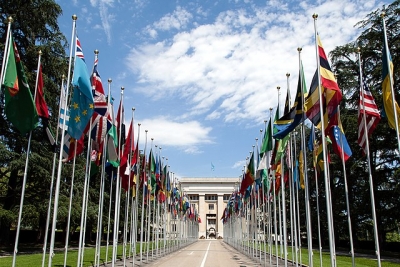
Flags of most countries of the world have interesting stories that are a mix of their political, cultural and social histories. Here are six flags with unique backstories.
NEPAL
One of the only non-quadrilateral flags in the world, this one consists of two crimson-red triangles, with a deep blue border. While the red symbolises bravery, it is also the colour of the rhododendron, the colour of Nepal’s national flower. The blue signifies peace. The current flag was adopted in 1962 along with the formation of a new constitutional government.
AUSTRIA
Legend has it that the flag of Austria was inspired by the colour of blood. The flag is believed to have been invented by Duke Leopold V of Austria, who, during a fierce battle, was drenched in blood. Every bit of his white surcoat was soaked in blood, except the portion underneath his belt. When he removed his belt, a white strip was revealed and the duke was struck by the combination of red-white-red and he is said to have adopted the colours as his banner. The flag’s first recorded use is believed to be in 1230.
BHUTAN
A white druk sprawls across the flag of Bhutan. Druk in Bhutanese means dragon. Known as the ‘Land of the Thunder Dragon’, it seems only fair that the flag carries an image of the mythical creature. The flag was designed in 1947, but the current design with yellow and orange has been in use since 1969. The white of the dragon signifies the purity of inner thoughts and deeds and it holds a jewel in each of its claws. The flag of Wales also sports a red dragon.
SOUTH SUDAN
Adopted in 2005, the flag of South Sudan is one of the newest in the world. It was adopted after the signing of the Comprehensive Peace Agreement that ended the second Sudanese Civil War. The flag is older than the country itself-South Sudan became an independent country in 2011. While it carries the pan-African colours, the blue in the flag symbolises the Nile river, the country’s lifeline.
DENMARK
The flag of Denmark holds the record for being the oldest continuously-used national flag. A deep red with a white cross, the flag is believed to have its origins in the 14th century. When the Danes were about to lose the battle against the Estonian tribes in 1219, the flag is said to have miraculously fallen from the sky, filling the Danish troops with hope and courage. The Danes won the war, too.
BOTSWANA
A flag that asks for rain. The blue colour of the flag of Botswana, a semi-arid region in the Kalahari desert, is a prayer for rain. The colour also symbolises hope. The black and white stripes indicate racial harmony. It is one of the few African flags that dont use red, yellow or green, which most African nations use as part of Pan Africanism, a movement that aims to strengthen bonds between the African indigenous groups.
Picture Credit : Google



